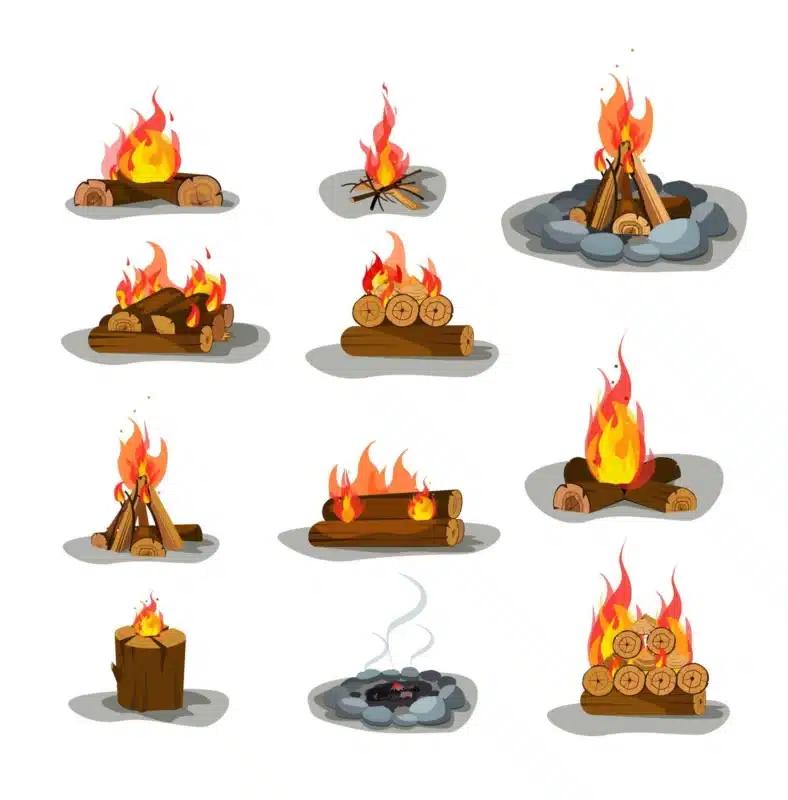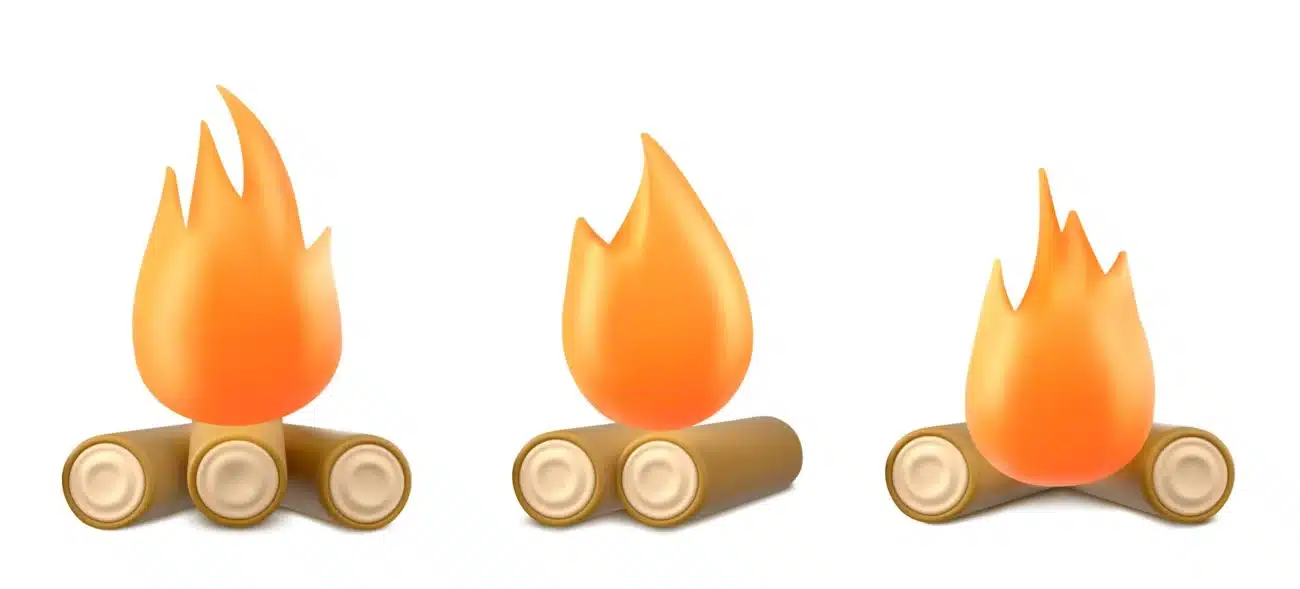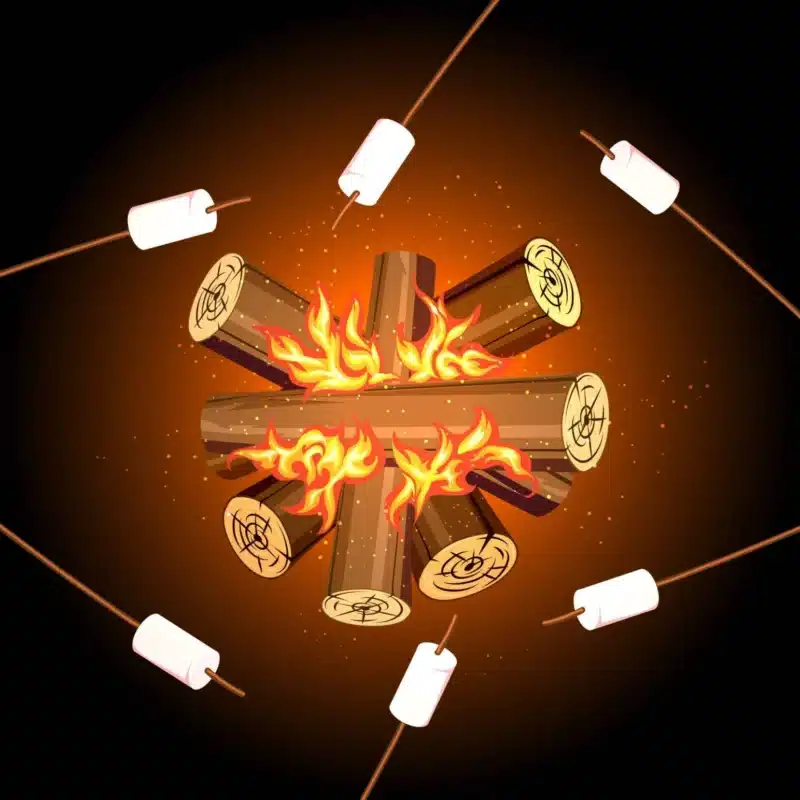Choosing the wrong kind of fire in the wild can turn a trip into a cold, fuel-wasting mess — especially if you don’t know which fire works best for cooking, heat, or stealth. At Outzpire, we’ve tested every major campfire structure in forests, deserts, and rainy terrain. This guide covers what works, when, and how — whether you’re grilling on a campfire fire pit or using a top-down fire for efficient heat.

Why Campfire Types Matter in the Outdoors
Understanding the meaning of campfire helps campers choose the right fire for warmth, cooking, and survival in nature.
Campfires aren’t just flames in the dark — they’re tools. The structure of a fire affects heat output, cooking potential, fuel efficiency, and smoke direction. That’s why experienced campers rely on different types of campfires depending on the terrain, weather, group size, and purpose. Knowing these types helps you build smarter fires and stay safer outdoors.

Types of Campfires Explained: Structure, Use Cases, and How to Build Them
A guide to campfire fire pit setups and various types of fire you can build depending on your outdoor needs.
Here’s a breakdown of the 14 essential types of campfires, each serving different purposes in camping, survival, or cooking:
Teepee Campfire
Description: Logs or sticks are stacked vertically into a cone shape.
How to build it: Place tinder at the center, surround with kindling in a cone shape, and light from the bottom.
Best use cases: Quick-start fires, boiling water, early-stage warmth.

Log Cabin Fire
Description: Built like a small cabin — layers of logs stacked perpendicularly.
How to build it: Create a teepee inside, then stack larger logs in a square shape around it.
Best use cases: Stable fire with longer burn time and easy airflow.

Star Fire
Description: Several logs laid like spokes of a wheel with fire in the center.
How to build it: Place 4–6 logs pointing into a center point, and feed them as they burn inward.
Best use cases: Low fuel usage, ideal for overnight slow burns.

Lean-To Fire
Description: Tinder is protected under a log or rock, with sticks leaning against it.
How to build it: Position a large log as a wind block, lean kindling across it, and light from the protected side.
Best use cases: Windy environments and wet conditions.

Dakota Fire Hole
Description: A stealthy fire built in two underground holes connected by a tunnel.
How to build it: Dig a fire chamber and a second vent hole; light fire in the main hole.
Best use cases: Stealth camping, fuel efficiency, low smoke.

Swedish Torch
Description: A single log is split vertically into quarters and lit from the center.
How to build it: Cut a large log vertically into 4 sections, stand upright, and light kindling in the center.
Best use cases: Cooking on top of the log, long-lasting flame.

Keyhole Fire
Description: Round fire area with a cooking trench extended like a keyhole.
How to build it: Build main fire in the circle, rake hot coals into the trench for cooking.
Best use cases: Campfire cooking with separate heat control.

Pyramid Fire
Description: Logs stacked in layers, smallest at top — like a reverse log cabin.
How to build it: Lay largest logs on the bottom, smaller ones above, light from the top.
Best use cases: Slow, self-feeding fire for minimal management.

Parallel Fire
Description: Two long logs laid parallel with the fire between them.
How to build it: Place kindling and tinder between two thick logs.
Best use cases: Wind protection and cooking support for pots or pans.

Criss-Cross Fire
Description: Alternating layers of logs and kindling in a grid layout.
How to build it: Stack logs in a criss-cross pattern, light from the top or side.
Best use cases: Stable base for long burns, steady coals for cooking.

Upside Down Fire
Description: This uses the top down fire method, where the flame starts at the top and burns downward.
How to build it: Stack big logs on the bottom, medium above, then kindling and tinder on top. Light from the top.
Best use cases: Low-maintenance, long-lasting heat, less smoke.

Trench Fire
Description: Fire built in a shallow trench for wind protection and control.
How to build it: Dig a narrow trench and build fire inside it.
Best use cases: Tactical or emergency cooking setups.

Council Fire
Description: Similar to a log cabin fire but larger and surrounded by multiple fuel sources.
How to build it: Construct a central teepee, encircled by evenly spaced upright logs.
Best use cases: Group gatherings or ceremonies needing large, high flames.

Reflector Fire
Description: Standard fire with a reflector wall behind it to direct heat forward.
How to build it: Build a normal fire, place a wall of rocks or logs behind it.
Best use cases: Staying warm at night with minimal fuel.

Best Wood for Campfires and Bonfires
Choosing good campfire wood depends on heat output, smoke level, and availability. Whether you’re selecting logs for a fire pit or wood for bonfires, here’s what to know.
- Hardwoods (oak, maple, hickory): Long-burning, less smoke. Ideal for cooking and cold nights.
- Softwoods (pine, fir, spruce): Easy to light, but burn quickly and produce sparks.
- Avoid green wood or resin-heavy logs indoors or under tarps due to smoke and creosote.
- Know the difference between bonfire and campfire: bonfires are larger and often ceremonial; campfires are practical and contained.
Fire Starters and Pre-Packaged Campfire Logs
When you’re short on time or in wet weather, outdoor fire logs and reliable fire starters can make the difference between frustration and ignition.
- Store-bought fire starters (wax cubes, sawdust bricks) are compact and dependable.
- Pre-packaged outdoor fire logs are ideal for RVs, car camping, or quick ignition in wet conditions.
- Carry waterproof matches or a stormproof lighter as backups.
Campfire Safety and Leave No Trace Practices
Building a fire comes with responsibility — especially in shared or sensitive ecosystems.
- Always check local fire regulations and bans.
- Use designated fire rings or dig a small pit surrounded by rocks.
- Clear away flammable debris.
- Never leave a fire unattended.
- Extinguish with water, stir ashes, and repeat until cold.
- Pack out ash and leftover wood to leave no trace.
Different Types of Campfires – FAQs
How do you build a teepee fire?
Start by placing a small pile of dry tinder at the center of your fire area. Surround it with kindling in a cone or teepee shape, leaving space for air to flow. Lean small sticks vertically around the tinder, then layer slightly thicker branches over that. Light the tinder at the base — the flames will rise and ignite the upper layers.
What’s the best way to stack firewood in a fire pit?
The best stacking method depends on your goal. Use the teepee structure for quick ignition and a high flame, or a log cabin fire for stability and longer burn time. If you want steady, low-maintenance heat, go with a pyramid or upside down fire by stacking large logs at the bottom and layering smaller fuel upward.
How do you construct a strong and lasting campfire?
Step 1: Clear a circular area on flat ground, at least 6 feet in diameter.
Step 2: Line the perimeter with large rocks to create a fire ring (if none exists).
Step 3: Lay small sticks and twigs in the center as your kindling base.
Step 4: Add dry leaves, bark, or grass on top of the kindling for tinder.
Step 5: Build your chosen fire structure (teepee, log cabin, etc.) over the kindling.
Step 6: Light the tinder using matches or a lighter, shielding the flame from wind.
How hot does a campfire or bonfire get?
Campfires typically burn between 600°C and 1,100°C (1,100°F to 2,000°F) depending on wood type, oxygen flow, and structure. A well-ventilated fire like a Dakota fire hole or Swedish torch can reach higher temperatures due to focused airflow and efficient combustion.
What’s the difference between building a good fire and just starting one?
Starting a fire means getting flames going — often with little thought to structure, fuel, or efficiency. Building a good fire involves choosing the right layout (like log cabin or star fire), ensuring proper airflow, using dry materials, and planning for safety and purpose — whether for cooking, warmth, or low smoke.
How do you make a campfire in ARK: Survival Evolved?
Step 1: Collect 12 Thatch, 1 Flint, 16 Stone, and 2 Wood.
Step 2: Place the campfire on the ground in a safe area.
Step 3: Open its inventory and add fuel (Wood, Thatch, Sparkpowder, or AnglerGel).
Step 4: Select “Light Fire” to ignite it and begin cooking or warming up.
How to start fire with rocks?
Hold the flint or chert in one hand and the steel striker in the other.
Angle the steel at about 45 degrees against the edge of the rock.
Strike firmly downward to produce sparks, aiming them onto a dry tinder nest made of char cloth, bark, or grass.
Blow gently on the sparks to ignite the tinder, then transfer it to your fire lay.




 VEVOR
VEVOR FlashFish
FlashFish GoFort
GoFort OutSunny
OutSunny ANTARCTICA Gear
ANTARCTICA Gear
